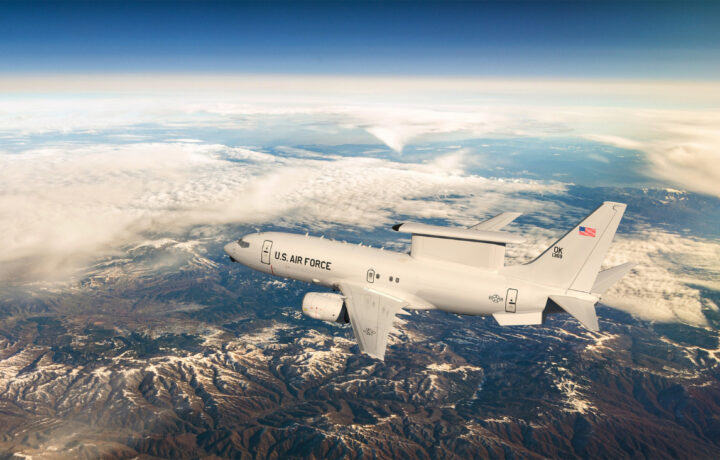Aerospace giant Boeing started development this year on two new U.S. variants of the E-7 Airborne Early Warning & Control (AEW&C) aircraft through a $1.2 billion Undefinitized Contract Action. The E7 can provide the United States Air Force with a fully integrated, combat-proven, flexible command and control node that can deliver multi-domain awareness in some of the most challenging operational environments.
NATO Picks E-7A Wedgetail
This month, NATO followed the lead of the U.S. Air Force, and selected the E-7A Wedgetail to replace its E-3A Sentry Airborne Warning and Control System (AWACS) aircraft after alliance members approved the procurement of half a dozen of the newer platforms.
“Surveillance and control aircraft are crucial for NATO’s collective defense and I welcome Allies’ commitment to investing in high-end capabilities,” said NATO Secretary General Jens Stoltenberg in a statement. “By pooling resources, Allies can buy and operate major assets collectively that would be too expensive for individual countries to purchase. This investment in state-of-the-art technology shows the strength of transatlantic defence cooperation as we continue to adapt to a more unstable world.”
Currently, NATO members Türkiye and the United Kingdom – in addition to the U.S. Air Force – already operate the E-7 Wedgetail. It is also in service with the Royal Australian Air Force and the Republic of Korea Air Force.
In total, six E-7s will be acquired to replace the current 14-strong NATO fleet of Boeing E-3 Sentry aircraft and serve in the initial Alliance Future Surveillance and Control (iAFSC) capability. Initial operational capability is planned for 2031
Options Considered
Even though the Air Force operates the E-7, it wasn’t a foregone conclusion that NATO would adopt the aircraft. However, the decision to select the E-7—by a consortium of nations including Belgium, Germany, Luxembourg, the Netherlands, Norway, Romania, and the U.S.—follows the December 2022 publication by the NATO Support and Procurement Agency (NSPA) of a request for information for alternative AEW platforms, Aviation Week first reported.
Several options were considered.
Saab offered its GlobalEye, while Northrop Grumman proposed the E-2 Hawkeye, and L3Harris offered a modified AEW conversion of the Bombardier Global 6500.
E-7A is NATO’s Radar in the Sky
The E-7 was selected as being the only platform that was deemed capable of fulfilling the strategic commands’ essential operational requirements, met the key performance parameters, and was available for delivery within the timeframe required by the international alliance. The E-7 was deemed to have the best surveillance coverage capability and grown capacity.
The E-7 also was noted for its endurance, crew size, number of workstations, and even crew rest areas. It also employs a well-established supply chain that could significantly reduce maintenance and logistic costs, while increasing mission readiness on day one.
The E-7 Wedgetail is a conversion of the Next-Generation 737-700, and serves as an advanced early warning and control aircraft that provides situational awareness and command and control functions. It is noted for being equipped with a powerful radar, the aircraft can detect hostile aircraft, missiles, and ships at great distances and can direct NATO fighter jets to their targets.
Replacing the E-3A AWACS
The six E-7s will replace NATO’s fleet of E-3A Airborne Warning and Control (AWACS) aircraft that have been operated since the 1980s.
Based at Geilenkirchen airbase in Germany, the AWACS have flown in every major NATO operation, including the fight against ISIS as well as on NATO’s eastern flank following Russia’s invasion of Ukraine. The E-7 is expected to have its main base at Geilenkirchen and could operate from several forward locations across Europe.
However, it has been noted that a future fleet of six represents less than half the number of NATO E-3s currently in service, but according to the NSPA, six is the “minimum number of aircraft that the strategic commands state are required to deliver the minimum operational capability for Supreme Allied Commander Europe’s day-zero airborne air battle management capability.”
The UK’s Royal Air Force is currently acquiring three E-7s to replace a fleet of originally seven E-3s, while the U.S. Air Force plans to buy 26.
According to reports, officials at Swedish-based Saab were unhappy with the decision.
“From a technological point of view, GlobalEye is meeting or exceeding all capabilities set forth in the [request],” the Swedish company states, adding, “GlobalEye is pushing technology to levels that legacy thinking will miss out on.”
Last year, Saab voiced similar opposition after Canada selected the Lockheed Martin F-35 Lightning II over its JAS-39 Gripen jet fighter.




